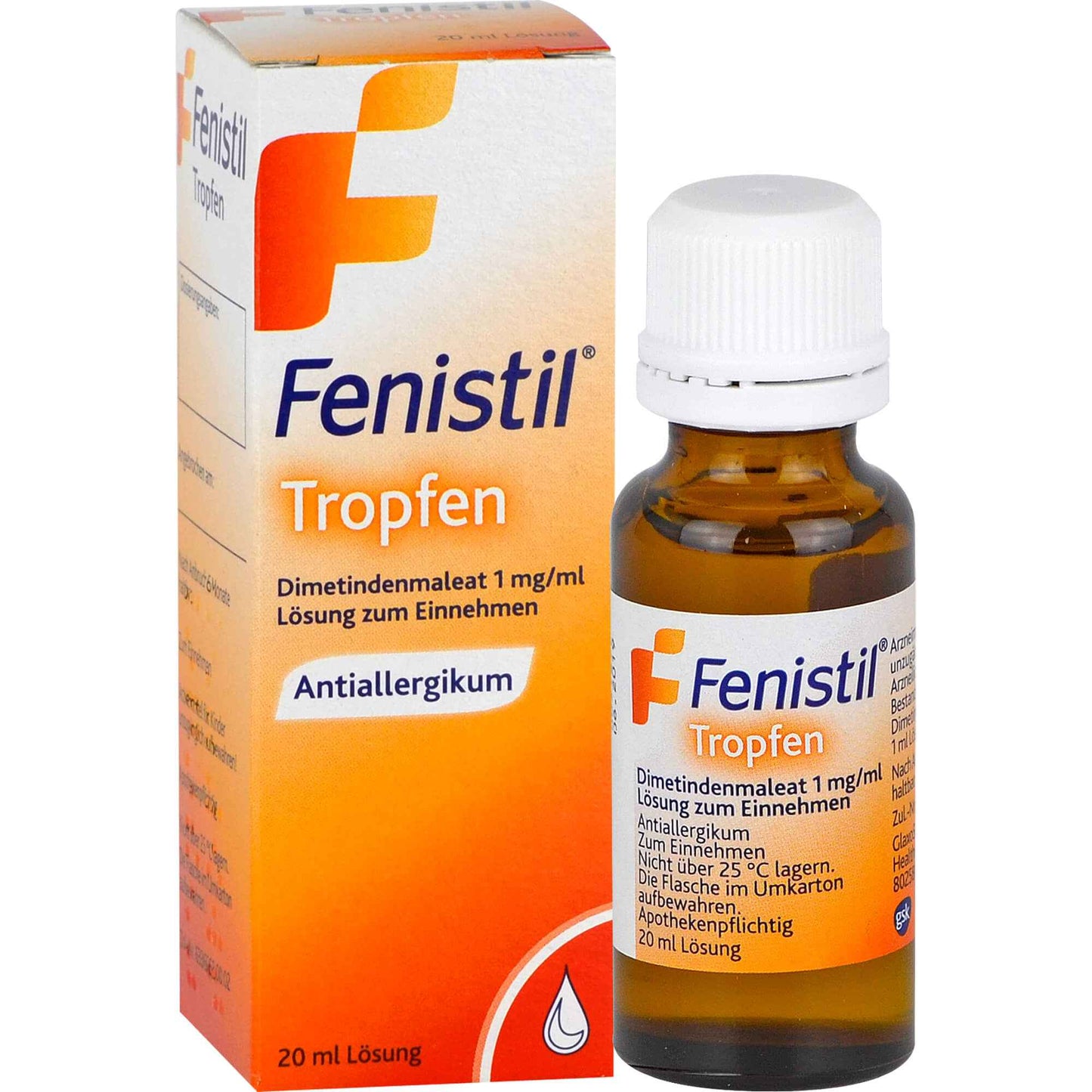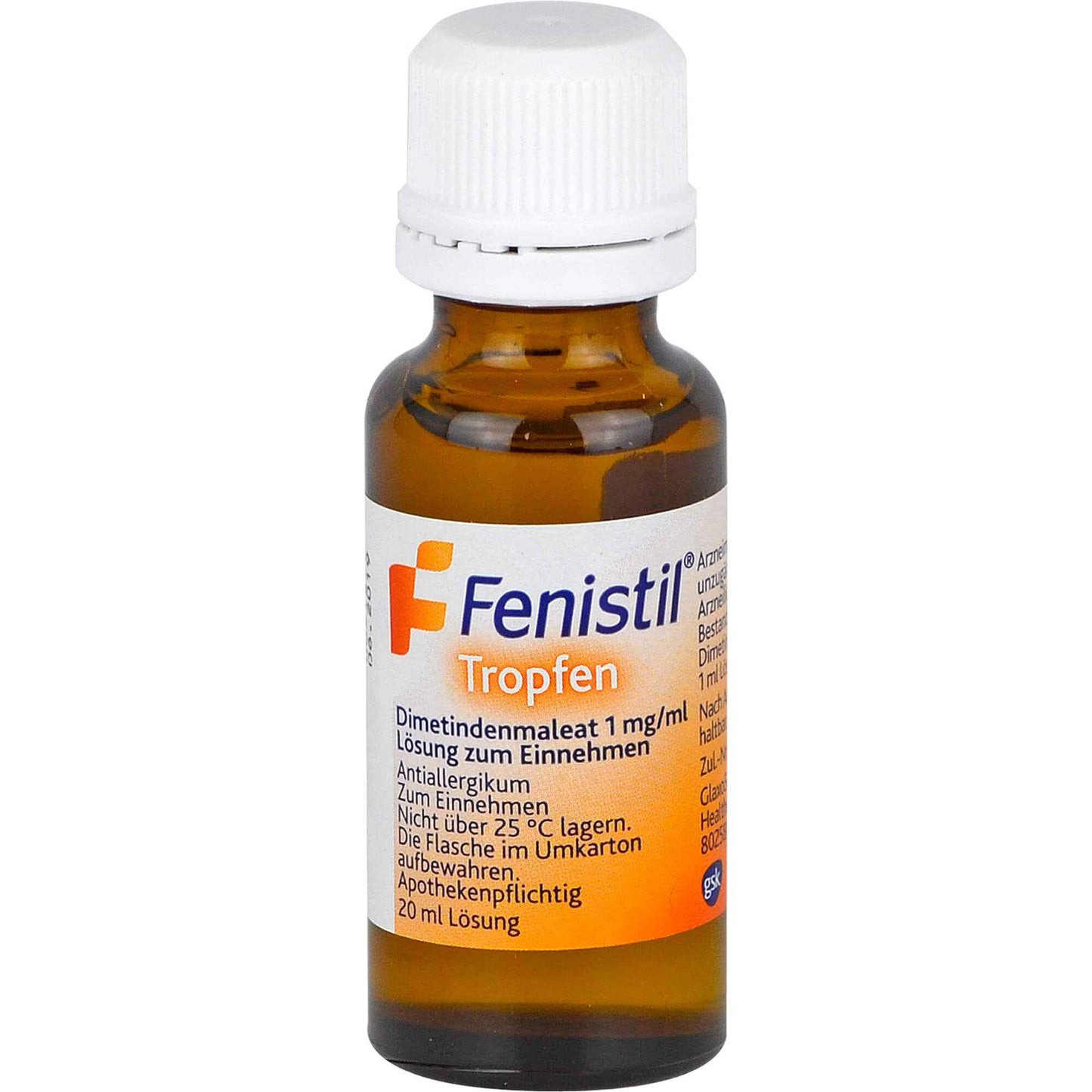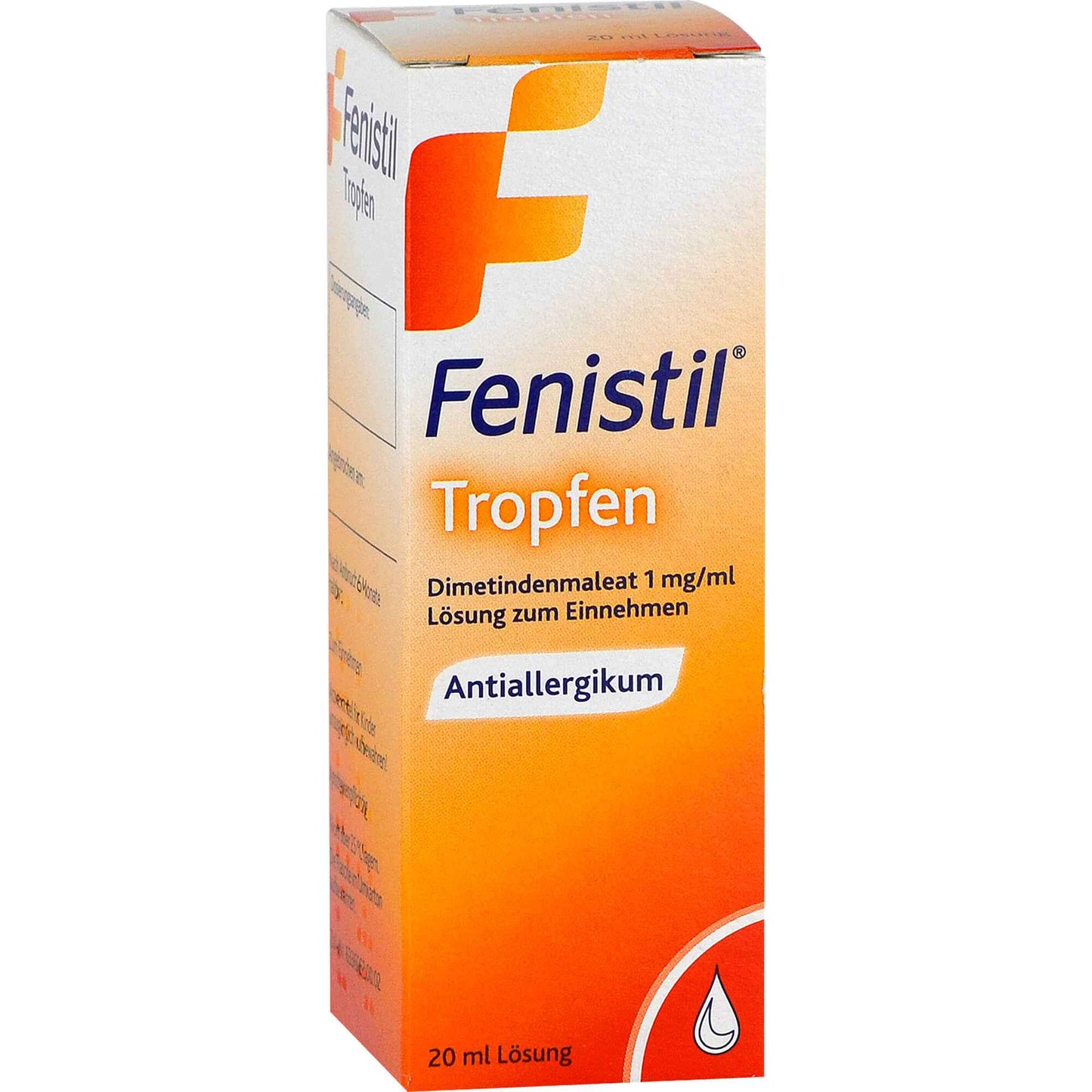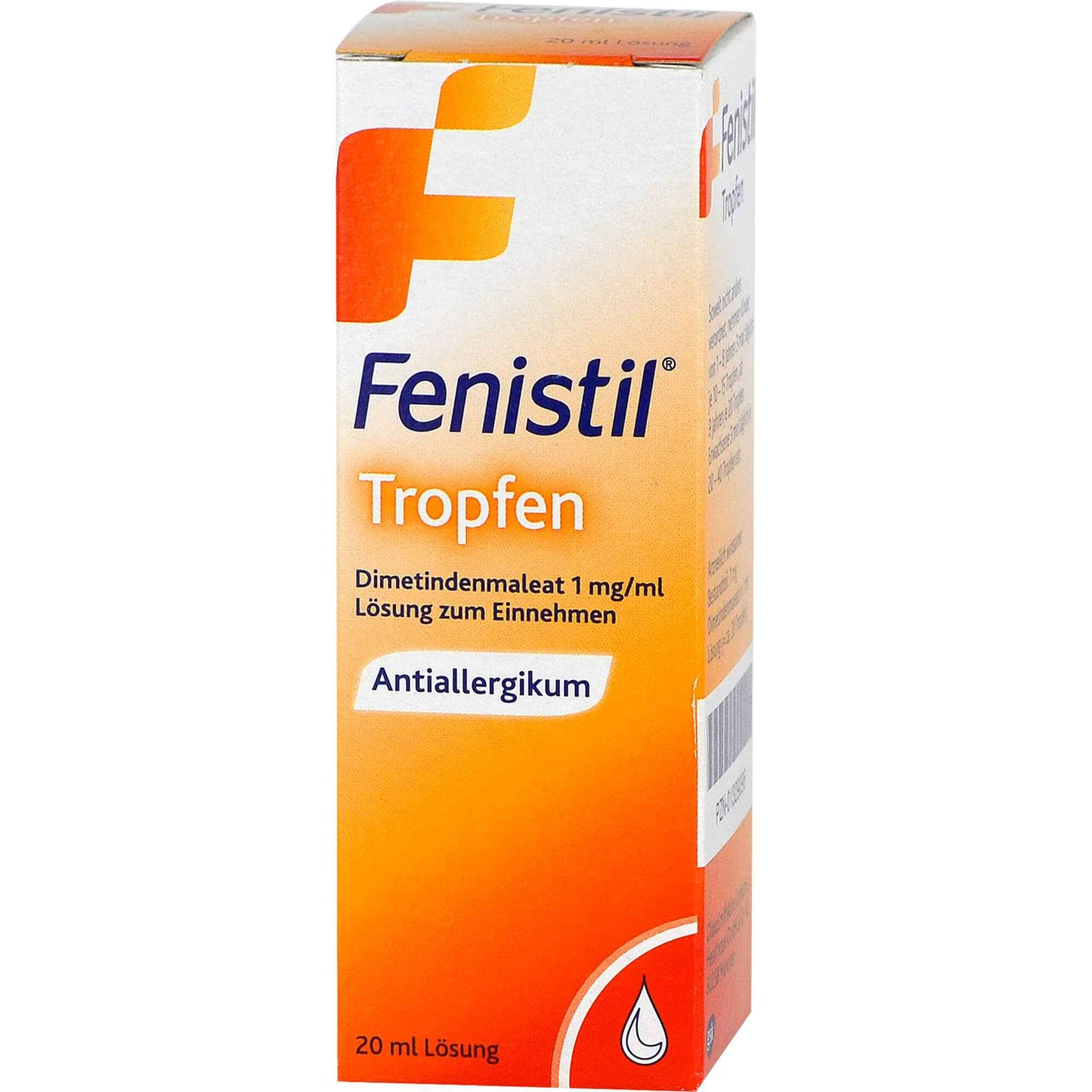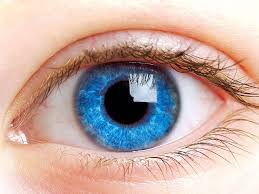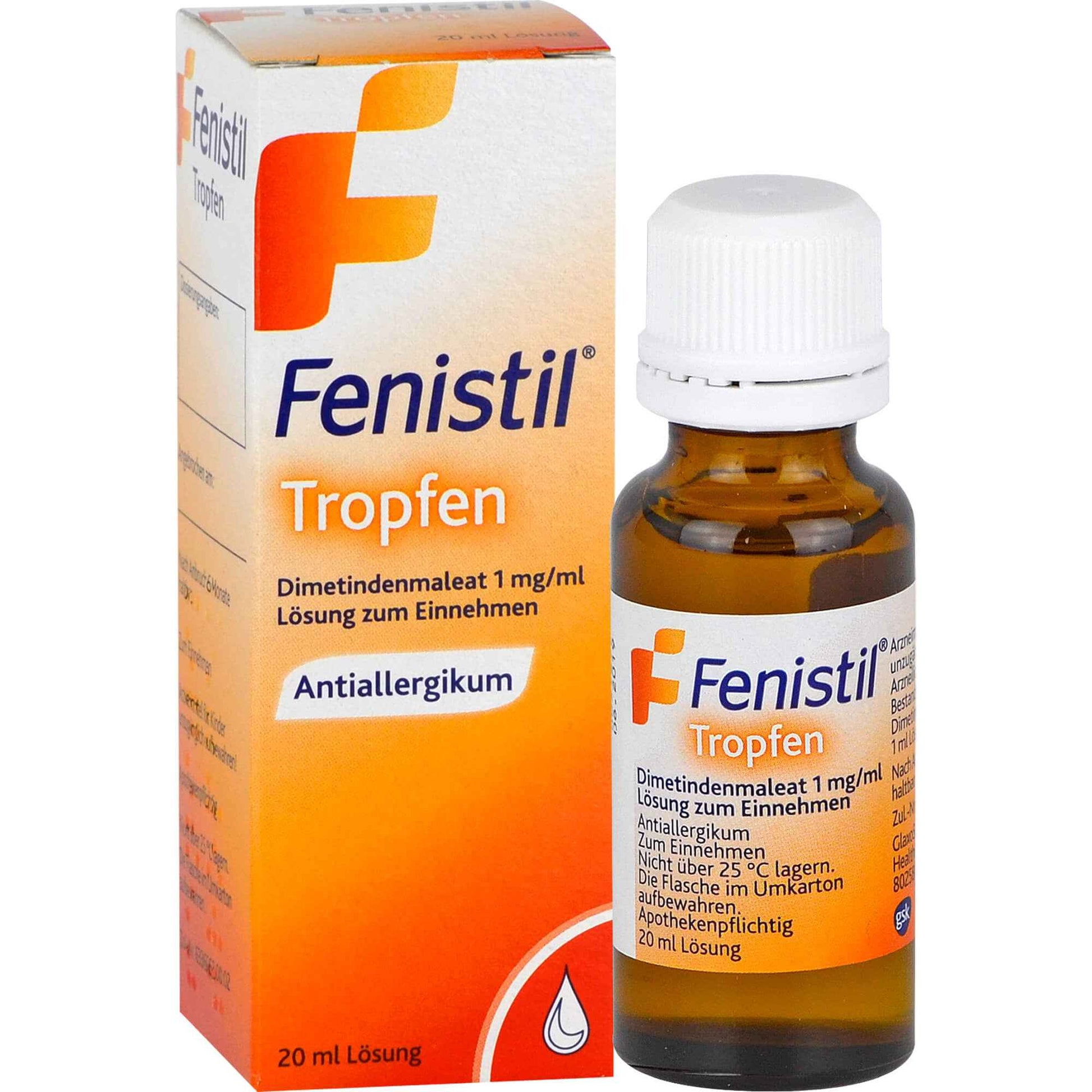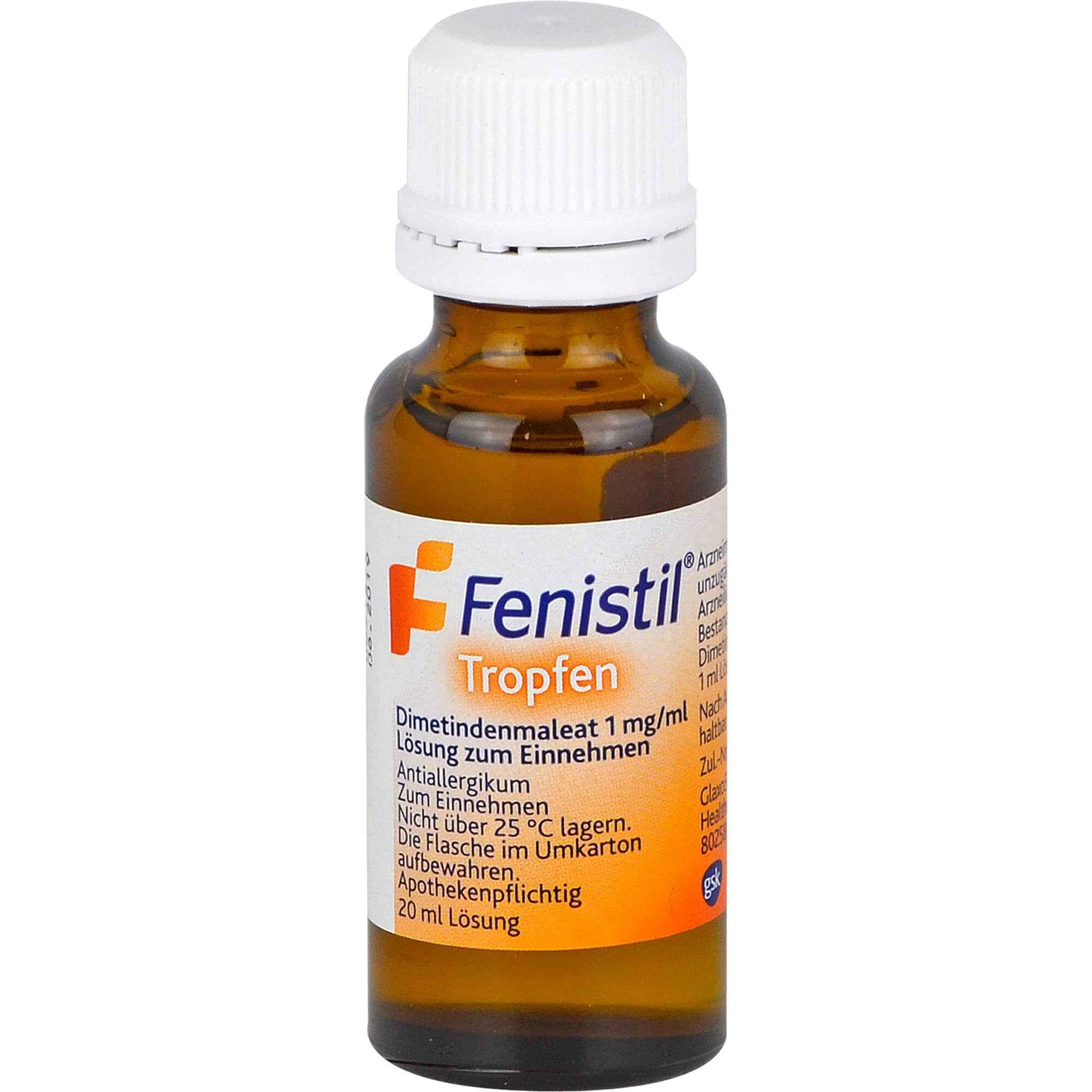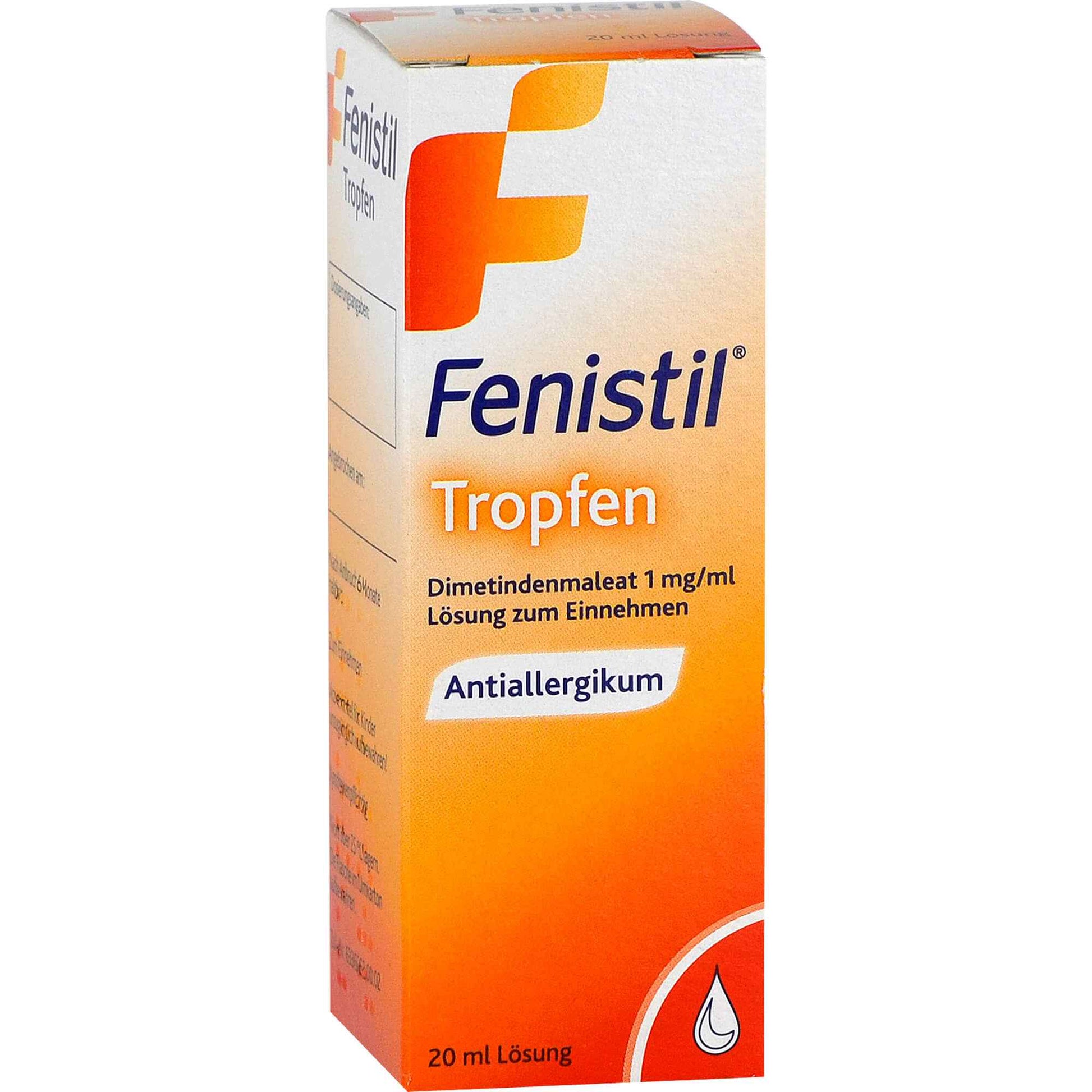EMRA-MED Arzneimittel GmbH
Itching, chickenpox, allergic rhinitis, insect bites, FENISTIL drops
Itching, chickenpox, allergic rhinitis, insect bites, FENISTIL drops
Couldn't load pickup availability
FENISTIL Itching, chickenpox, allergic rhinitis, insect bites drops
- Pack size:
- 20 ml
- Dosage form:
- drops
Fenistil drops. Active ingredient: Dimetindene maleate. Indications: For the symptomatic relief of histamine-induced itching%%% chickenpox-associated itching in small children%%% allergic rhinitis in patients over 6 years of age%%% hives (urticaria)%%% insect bites.
For risks and side effects, read the package leaflet and ask your doctor or pharmacist!
PACKAGE LEAFLET: INFORMATION FOR THE USER
Fenistil drops, oral solution
Active ingredient: Dimetindene maleate 1 mg/ml
Read the entire package leaflet carefully before you start taking this medicine because it contains important information. Always take this medicine exactly as described in this leaflet or exactly as your doctor or pharmacist has told you.
- Keep this leaflet. You may want to read it again later.
- Ask your pharmacist if you need further information or advice.
- If you experience any side effects, talk to your doctor or pharmacist. This includes any possible side effects not listed in this leaflet. See section 4.
- If you do not feel better or if you feel worse, consult your doctor.
What is in this leaflet:
- WHAT ARE FENISTIL DROPS AND WHAT ARE THEY TAKEN FOR?
- WHAT SHOULD YOU CONSIDER BEFORE TAKING FENISTIL DROPS?
- HOW SHOULD YOU TAKE FENISTIL DROPS?
- WHAT SIDE EFFECTS ARE POSSIBLE?
- HOW SHOULD FENISTIL DROPS BE STORED?
- CONTENTS OF THE PACK AND OTHER INFORMATION
1. WHAT ARE FENISTIL DROPS AND WHAT ARE THEY USED FOR?
Fenistil drops contain dimetindene maleate. They belong to a group of medicines called antihistamines. They are used to relieve the symptoms of allergies such as rashes, itching, hay fever, or other allergic rhinitis. Fenistil drops inhibit the action of histamine. Histamine is a substance released by the body during an allergic reaction. It relieves the itching and irritation caused by the rash, reduces swelling, and relieves the symptoms of allergic rhinitis such as a runny nose, sneezing, itchy nose, and itchy, watery eyes.
Indications:
For the symptomatic relief of:
- histamine-induced itching%%%
- chickenpox-associated itching in young children%%%
- allergic rhinitis in patients over 6 years of age%%%
- Hives (urticaria)%%%
- Insect bites.
Itching, chickenpox, allergic rhinitis, insect bites
2. WHAT SHOULD YOU CONSIDER BEFORE TAKING FENISTIL DROPS?
Fenistil drops should not be taken:
- if you are allergic to dimetindene maleate or any of the other ingredients of this medicine listed in section 6.
- Infants and children under 1 year of age should not take Fenistil drops.
Warnings and Precautions:
Please talk to your doctor before taking Fenistil Drops if any of the following applies to you:
- glaucoma
- Congenital or acquired enlargement of the prostate (bladder neck stenosis/prostatic hypertrophy)
- Epilepsy.
Itching, chickenpox, allergic rhinitis, insect bites
Children and adolescents:
Antihistamines may cause agitation in younger children.
Taking Fenistil Drops with other medicines:
Tell your doctor or pharmacist if you are taking/using, have recently taken/used, or intend to take/use any other medicines.
Itching, chickenpox, allergic rhinitis, insect bites
Fenistil Drops should only be taken after consulting your doctor if you are taking/using the following medicines:
- Antidepressants (tricyclic antidepressants and monoamine oxidase inhibitors)
- Anticholinergics such as medicines for asthma or bronchospasms, stomach or abdominal cramps, pupil-dilating medicines (mydriatics), medicines for urge incontinence and overactive bladder (urological antispasmodics)
- Medicines that depress the central nervous system (sedatives), anti-anxiety medications (anxiolytics) or sleeping pills (hypnotics, neuroleptics)
- Medicines for the treatment of epilepsy (anticonvulsants)
- strong, centrally acting painkillers (opioid analgesics)
- Antihistamines (medicines used to treat coughs, colds, or allergies)
- Medicines for nausea and vomiting (antiemetics)
- Procarbazine (medicine for treating cancer)
- Scopolamine (medicine for travel sickness)
- alcohol
Itching, chickenpox, allergic rhinitis, insect bites
The concomitant use of tricyclic antidepressants or anticholinergics may increase the risk of worsening glaucoma or urinary retention. In addition, the concomitant use of tricyclic antidepressants may trigger an attack in patients at risk of glaucoma.
Taking Fenistil Drops with alcohol:
Like many antihistamines, Fenistil Drops may increase the effects of alcohol. Alcohol may increase the sedative effect of Fenistil.
Pregnancy and breastfeeding:
If you are pregnant, think you may be pregnant, or are planning to become pregnant, ask your doctor or pharmacist before taking this medicine. The use of Fenistil Drops while breastfeeding is not recommended.
Driving and using machines:
Like many other antihistamines, Fenistil may cause drowsiness or impair alertness in some people. If this happens, caution should be exercised when driving or operating machinery. This applies even more when taken with alcohol.
3. HOW TO TAKE FENISTIL DROPS?
Take Fenistil drops exactly as described in this leaflet or as your doctor or pharmacist has told you. Consult your doctor or pharmacist if you are unsure.
The recommended dose is:
- Adults and adolescents 12 years and older take 20 to 40 drops 3 times daily. For patients prone to drowsiness, it is recommended to take 40 drops before bedtime and 20 drops in the morning.
- Children aged 1 to 11 years: The recommended daily dose is 2 drops per kg of body weight, divided into 3 doses. The body weight (KG) multiplied by 2, then divided by 3, equals the number of drops to be taken 3 times daily (2 x KG/3). Example: A child weighing 15 kg should take 10 drops 3 times daily.
Dosage examples:
| Weight in kg | Number of drops 3 times daily |
| 7.5 | 5 |
| 10.5 | 7 |
| 15 | 10 |
| 18 | 12 |
| 22.5 | 15 |
| 25.5 | 17 |
| 30 | 20 |
| 33 | 22 |
| 37.5 | 25 |
| 40.5 | 27 |
| 45 | 30 |
| 48 | 32 |
- Elderly people (65 years and older): Take the usual adult dose.
Instructions for use:
To apply drops, hold the bottle with the dropper pointing vertically downwards. If you have difficulty applying the drops, tap the bottom of the bottle several times with your finger. For patients who tend to be drowsy, it is recommended that you take 40 drops before going to bed and 20 drops in the morning. Take the drops undiluted (e.g. with a teaspoon).
Please talk to your doctor or pharmacist if you have the impression that the effect of Fenistil drops is too strong or too weak.
If you have taken more Fenistil drops than you should:
In the event of an overdose, please inform your doctor or pharmacist immediately so that they can decide on the severity and any further measures that may be necessary.
If you forget to take Fenistil drops:
Do not take a double dose to make up for a forgotten dose, but continue use as described in the dosage instructions.
If you stop taking Fenistil Drops: If
you interrupt treatment or stop using it prematurely, you must expect that the desired effect will not occur or that the condition may worsen. Therefore, please consult your doctor or pharmacist if you want to stop or interrupt treatment.
If you have any further questions on the use of this medicine, ask your doctor or pharmacist.
4. POSSIBLE SIDE EFFECTS?
Like all medicines, Fenistil Drops can cause side effects, although not everybody experiences them. Stop taking Fenistil Drops immediately and consult a doctor if you notice any of the following symptoms, which could be signs of an allergic reaction:
- Shortness of breath or difficulty swallowing
- Swelling of the face, lips, tongue or throat
- severe itching with rash, muscle cramps
These side effects are very rare (may affect up to 1 in 10,000 people).
Other side effects that may occur are usually mild and temporary. The more common side effects occur especially at the beginning of treatment.
Very common side effects (may affect more than 1 in 10 people):
- fatigue
Common side effects (may affect up to 1 in 10 people):
- sleepiness
- nervousness
Rare side effects (may affect up to 1 in 1,000 people):
- excitation
- Headaches, dizziness
- Stomach and intestinal discomfort, nausea, dry mouth, dry throat
Reporting of side effects:
If you notice any side effects, contact your doctor or pharmacist. This also applies to side effects not listed in this package leaflet. You can also report side effects directly to the Federal Institute for Drugs and Medical Devices, Dept. Pharmacovigilance, Kurt-Georg-Kiesinger-Allee 3, D-53175 Bonn, website: www.bfarm.de. By reporting side effects, you can help provide more information on the safety of this medicine.
5. HOW SHOULD FENISTIL DROPS BE STORE?
Keep this medicine out of the sight and reach of children. Do not use this medicine after the expiry date which is stated on the carton and label. The expiry date refers to the last day of that month. Storage conditions: Do not store above 25°C. Keep the bottle in the outer carton. Information on shelf life after opening: Once opened, use for 6 months.
6. CONTENTS OF THE PACK AND OTHER INFORMATION
What Fenistil Drops contain:
The active ingredient is dimetindene maleate. 1 ml of solution (approx. 20 drops) contains 1 mg dimetindene maleate. The other ingredients are: Purified water%%% Sodium monohydrogen phosphate dodecahydrate%%% Citric acid monohydrate%%% Benzoic acid%%% Disodium edetate%%% Sodium saccharin%%% Propylene glycol.
What Fenistil Drops look like and contents of the pack:
Fenistil Drops are a clear, colorless oral solution and are available in packs of 20 ml, 50 ml, and 60 ml (3 x 20 ml) of solution. Not all pack sizes may be marketed.
Pharmaceutical Entrepreneur and Manufacturer:
GlaxoSmithKline Consumer Healthcare GmbH & Co. KG
80258 Munich
Barthstraße 4
80339 Munich
This package leaflet was last revised in February 2025.
Source: Information from the package leaflet
. Version: 10/2024
Active ingredient: Dimetindene maleate. Indications: For the symptomatic relief of histamine-induced itching, chickenpox-associated itching in young children, allergic rhinitis in patients over 6 years of age, and insect bites.
Itching, chickenpox, allergic rhinitis, insect bites
Share
